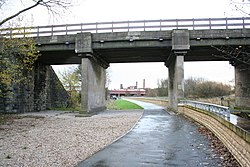Adam Viaduct
Adam Viaduct | |
|---|---|
 A view of the viaduct before the construction of the Southgate road. | |
| Coordinates | 53°32′28″N 2°38′52″W / 53.54098°N 2.64765°W |
| Carries | Kirkby branch line |
| Crosses | River Douglas, A49 Southgate link |
| Heritage status | Grade II listed building |
| Characteristics | |
| Material | Prestressed concrete |
| Total length | 120 feet (37 m) |
| Width | 29 feet 9 inches (9.07 m) |
| No. of spans | 4 |
| Rail characteristics | |
| Track gauge | 1,435 mm (4 ft 8+1⁄2 in) standard gauge |
| History | |
| Designer | William Kelly Wallace |
| Engineering design by | London, Midland & Scottish |
| Constructed by | Leonard Fairclough Ltd |
| Construction end | May 1946 |
| Replaces | 1847 timber bridge of the same name |
| Location | |
 | |
The Adam Viaduct is a grade II listed concrete underbridge in Wallgate, Wigan. Constructed in 1946, the bridge is the earliest prestressed concrete railway bridge in the United Kingdom, with only some examples in Switzerland being earlier.[1][2] It is bridge number 54 on the Kirkby branch line at a line distance of 18 miles 1,032 yards (29.91 km).[3]
History and construction

The bridge was created as a test case to see if prestressed concrete construction was feasible for rail projects in the UK by the LMS railway company.[4] The benefits of the system were found to be that it was quick to install, economical and long-lasting.[4] The concrete beams used were prestressed using the Freyssinet system in which concrete is put under compression, prior to installation, from high-tensile-strength metal 'tendons' inside of them. This system was developed in the 1930s and pre-stressed beams were first used for emergency repairs in World War Two, but the Adam Viaduct first to use them for a full-scale project.[1] The bridge has sixteen I-beams in each of its four spans and they are 2 feet 8 inches (0.81 m) deep.[5] It was erected in 1946 on the foundations of an earlier Victorian bridge (created as part of the Liverpool & Bury Railway in 1847) which was made from timber with masonry abutments.[4]
Road
In 2012 a bypass of the A49 road, from Pottery Road and the Saddle Junction, called Southgate Road was created that runs underneath the bridge, next to the River Douglas. It officially opened in March 2013 to reduce traffic in the area.[6]
References
- ^ a b "Adam Viaduct". Historic England. Retrieved 17 August 2018.
- ^ James Sutherland, R. J. M. Sutherland, Dawn Humm, Mike Chrimes (2001). Historic Concrete: Background to Appraisal. p. 254,258.
{{cite book}}: CS1 maint: multiple names: authors list (link) - ^ "Adam Viaduct Viaduct". The ABC Railway Guide. Retrieved 17 August 2018.
{{cite web}}: Cite has empty unknown parameter:|1=(help) - ^ a b c R. L. M'ilmoyle (20 September 1947). "Prestressed Concrete Bridge Beams Being Tested in England". Railway Age. Vol. 123. Simmons-Boardman Publishing Company. pp. 54–58.
{{cite book}}: Cite has empty unknown parameter:|1=(help) - ^ "Adam Bridge". Engineering Timelines. Retrieved 17 August 2018.
- ^ "New road relief". Wigan Today. 27 November 2012.
